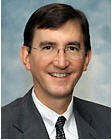Panel members included:
- James A. Brink, M.D., professor and chairman of the department of diagnostic radiology at Yale University School of Medicine in New Haven, Conn., and co-chairman of the joint Adult Radiation Protection Task Force cosponsored by the RSNA and the American College of Radiology (ACR).
- William R. Hendee, Ph.D., distinguished professor of radiology, radiation oncology, biophysics and bioethics at the Medical College of Wisconsin in Milwaukee.
- Christoph Wald, M.D., Ph.D., executive vice-chairman of the department of radiology at Lahey Clinic in Burlington, Mass., and associate professor of radiology at Tufts University Medical School in Boston; and
- Moderator Mary C. Mahoney, M.D., professor of radiology and director of Breast Imaging at the University of Cincinnati Medical Center and chair of the RSNA Public Information Committee.

James A. Brink, M.D. Image courtesy of Yale University School of Medicine.
To read the rest of this news, please visit:
